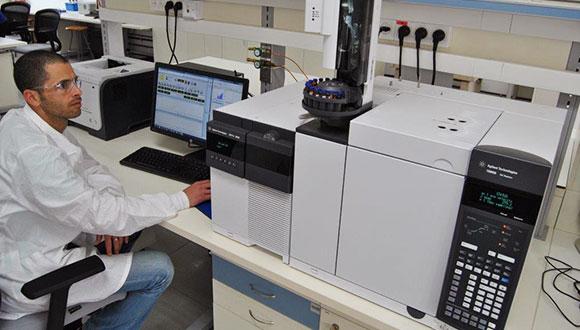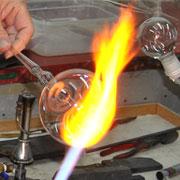University Analytical Chemistry Lab
The Tel Aviv University Center for Analytical Chemistry and The ADAMA Center for Novel Delivery Systems in Crop Protection operate at the School of Chemistry of TAU and offer an efficient and responsive solution to a variety of analytical needs.
The centers have a comprehensive collection of key analytical instruments and their operation know-how. Our core analytical techniques include:
Mass Spectrometry (GC-MS) - A common type of chromatography used in analytical chemistry for the separation and analysis of volatile and semi-volatile compounds. Typical uses of GC-MS include separation of components of a mixture, and identification and quantification of particular substances. GC-MS enables the detection, with additional identification and structural information via fragment masses, library identification, and isotope abundance analyses for elemental formulas.
Gas Chromatography (GC- FID/ECD) - Integrated with great separation capability of GC, FID provides a fast response time and high sensitivity for analytes containing hydrocarbon-based residues. ECD is dedicated for highly sensitive detection of electronegative compounds such as halogens, nitro groups, etc. Specifically, ECD is designed for the detection of explosives, poly chlorinated pesticides, fire retardant and other environmentally and biologically active materials.
Liquid Chromatography (HPLC) – Analytical High-Performance Liquid Chromatography is used for the separation, identification and quantification of a wide range of mixture compounds. The variety of available columns allows a comprehensive range of separations and applications. Our HPLC is equipped with a Diode Array detector for flexibly UV-VIS absorption detection.
Flame Atomic Emission/Absorption Spectroscopy (AAS/AES) - Analytical technique that measures the concentrations of elements (mainly metals). Atomic absorption detection limits are in the low ppm and even sub-ppm range. The systems also include flame atomic emission capability.
Inductively Coupled Plasma-Mass Spectrometry (ICP-MS) - uses an inductively coupled plasma to ionize the sample. It atomizes the sample and creates atomic and small polyatomic ions, which are then detected single quadrupole mass spectrometer. It is used to detect metals and several non-metals in liquid samples at very low concentrations. It can detect different isotopes of the same element, which makes it a versatile tool in Isotopic labelling. Compared to atomic absorption spectroscopy, ICP-MS has greater speed, precision, and sensitivity.
Particle Size Analyzer (PSA) - based on static light scattering or laser diffraction (LD) is a popular and widely used instrumentation for measuring particles from hundreds of nanometres to several millimetres. In LD PSAs, a laser beam is used to irradiate a dilute suspension of particles. The light scattered by the particles in the forward direction is focused by a lens onto a large array of concentric photodetector rings. The smaller the particle is, the larger the scattering angle of the laser beam is. Thus, by measuring the angle-dependent scattered intensity, one can infer the particle size distribution using Fraunhofer or Mie scattering models. In the latter case, prior knowledge of the refractive index of the particle being measured as well as the dispersant is required.
Contact Angle Measurements - the optical analysis of drops that hang from a dosing needle or are placed on a solid surface facilitates the determination of different surface and interfacial parameters. The contact angle that a liquid drop establishes on a solid surface characterises the solid’s wetting behaviour with said liquid.
Viscosimeter - rotational viscometers use the idea that the torque required to turn an object in a fluid is a function of the viscosity of that fluid. They measure the torque required to rotate a disk or bob in a fluid at a known speed.
Rheometer - is a laboratory device used to measure the way in which a liquid, suspension or slurry flows in response to applied forces. It is used for those fluids which cannot be defined by a single value of viscosity and therefore require more parameters to be set and measured than is the case for a viscometer.
Density Meter - based on the oscillating U-tube principle. The tube, usually a U shaped glass tube, is excited and starts to oscillate at a certain frequency depending on the filled-in sample. Through determination of the corresponding frequency the density of the sample can be calculated.
Refractometer - suitable to measure the Refractive Index Scale and the BRIX scale for liquid and solid samples.
Our analytical equipment and facilities are primarily used to support the university research community, but we also gladly assist government, industry, and the public with analytical chemistry solutions.
We aim to provide a first class analytical service and offer unique knowledge to assist with any complex or simple technical issue. We are capble to accommodates the special needs of clients, such as analytical method development and support for specific research projects, both large and small.
The centers also welcome graduate and undergraduate students, providing the necessary training and hands-on access to advanced analytical equipment and allowing them to develop essential research and work skills with the equipment.
To find out more regarding the services provided and additional analytical solutions, you are welcome to contact Dr. Alexander Gordin via Email or by telephone 03-6408270 / 052-8010041. For further assistance - we will be happy to discuss all available options.
Scheduling for registered users >





